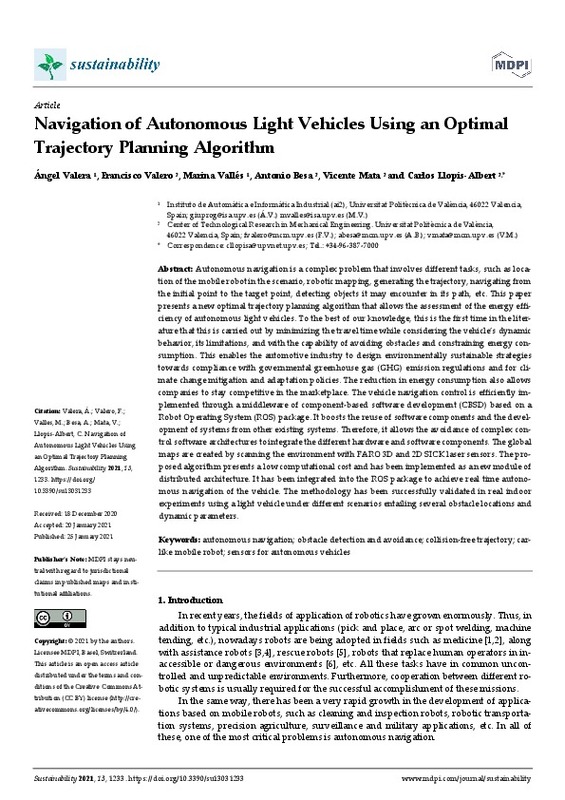JavaScript is disabled for your browser. Some features of this site may not work without it.
Buscar en RiuNet
Listar
Mi cuenta
Estadísticas
Ayuda RiuNet
Admin. UPV
Navigation of Autonomous Light Vehicles Using an Optimal Trajectory Planning Algorithm
Mostrar el registro sencillo del ítem
Ficheros en el ítem
| dc.contributor.author | Valera Fernández, Ángel
|
es_ES |
| dc.contributor.author | Valero Chuliá, Francisco José
|
es_ES |
| dc.contributor.author | Vallés Miquel, Marina
|
es_ES |
| dc.contributor.author | Besa Gonzálvez, Antonio José
|
es_ES |
| dc.contributor.author | Mata Amela, Vicente
|
es_ES |
| dc.contributor.author | Llopis-Albert, Carlos
|
es_ES |
| dc.date.accessioned | 2022-05-24T18:05:08Z | |
| dc.date.available | 2022-05-24T18:05:08Z | |
| dc.date.issued | 2021-02 | es_ES |
| dc.identifier.uri | http://hdl.handle.net/10251/182877 | |
| dc.description.abstract | [EN] Autonomous navigation is a complex problem that involves different tasks, such as location of the mobile robot in the scenario, robotic mapping, generating the trajectory, navigating from the initial point to the target point, detecting objects it may encounter in its path, etc. This paper presents a new optimal trajectory planning algorithm that allows the assessment of the energy efficiency of autonomous light vehicles. To the best of our knowledge, this is the first time in the literature that this is carried out by minimizing the travel time while considering the vehicle's dynamic behavior, its limitations, and with the capability of avoiding obstacles and constraining energy consumption. This enables the automotive industry to design environmentally sustainable strategies towards compliance with governmental greenhouse gas (GHG) emission regulations and for climate change mitigation and adaptation policies. The reduction in energy consumption also allows companies to stay competitive in the marketplace. The vehicle navigation control is efficiently implemented through a middleware of component-based software development (CBSD) based on a Robot Operating System (ROS) package. It boosts the reuse of software components and the development of systems from other existing systems. Therefore, it allows the avoidance of complex control software architectures to integrate the different hardware and software components. The global maps are created by scanning the environment with FARO 3D and 2D SICK laser sensors. The proposed algorithm presents a low computational cost and has been implemented as a new module of distributed architecture. It has been integrated into the ROS package to achieve real time autonomous navigation of the vehicle. The methodology has been successfully validated in real indoor experiments using a light vehicle under different scenarios entailing several obstacle locations and dynamic parameters. | es_ES |
| dc.description.sponsorship | This work has been partially funded by FEDER-CICYT project with reference DPI2017-84201-R financed by Ministerio de Economia, Industria e Innovacion (Spain). | es_ES |
| dc.language | Inglés | es_ES |
| dc.publisher | MDPI AG | es_ES |
| dc.relation.ispartof | Sustainability | es_ES |
| dc.rights | Reconocimiento (by) | es_ES |
| dc.subject | Autonomous navigation | es_ES |
| dc.subject | Obstacle detection and avoidance | es_ES |
| dc.subject | Collision-free trajectory | es_ES |
| dc.subject | Car- like mobile robot | es_ES |
| dc.subject | Sensors for autonomous vehicles | es_ES |
| dc.subject.classification | INGENIERIA MECANICA | es_ES |
| dc.subject.classification | INGENIERIA DE SISTEMAS Y AUTOMATICA | es_ES |
| dc.title | Navigation of Autonomous Light Vehicles Using an Optimal Trajectory Planning Algorithm | es_ES |
| dc.type | Artículo | es_ES |
| dc.identifier.doi | 10.3390/su13031233 | es_ES |
| dc.relation.projectID | info:eu-repo/grantAgreement/AEI/Plan Estatal de Investigación Científica y Técnica y de Innovación 2013-2016/DPI2017-84201-R/ES/INTEGRACION DE MODELOS BIOMECANICOS EN EL DESARROLLO Y OPERACION DE ROBOTS REHABILITADORES RECONFIGURABLES/ | es_ES |
| dc.rights.accessRights | Abierto | es_ES |
| dc.contributor.affiliation | Universitat Politècnica de València. Departamento de Ingeniería Mecánica y de Materiales - Departament d'Enginyeria Mecànica i de Materials | es_ES |
| dc.contributor.affiliation | Universitat Politècnica de València. Departamento de Ingeniería de Sistemas y Automática - Departament d'Enginyeria de Sistemes i Automàtica | es_ES |
| dc.description.bibliographicCitation | Valera Fernández, Á.; Valero Chuliá, FJ.; Vallés Miquel, M.; Besa Gonzálvez, AJ.; Mata Amela, V.; Llopis-Albert, C. (2021). Navigation of Autonomous Light Vehicles Using an Optimal Trajectory Planning Algorithm. Sustainability. 13(3):1-23. https://doi.org/10.3390/su13031233 | es_ES |
| dc.description.accrualMethod | S | es_ES |
| dc.relation.publisherversion | https://doi.org/10.3390/su13031233 | es_ES |
| dc.description.upvformatpinicio | 1 | es_ES |
| dc.description.upvformatpfin | 23 | es_ES |
| dc.type.version | info:eu-repo/semantics/publishedVersion | es_ES |
| dc.description.volume | 13 | es_ES |
| dc.description.issue | 3 | es_ES |
| dc.identifier.eissn | 2071-1050 | es_ES |
| dc.relation.pasarela | S\426299 | es_ES |
| dc.contributor.funder | AGENCIA ESTATAL DE INVESTIGACION | es_ES |
| dc.contributor.funder | European Regional Development Fund | es_ES |








